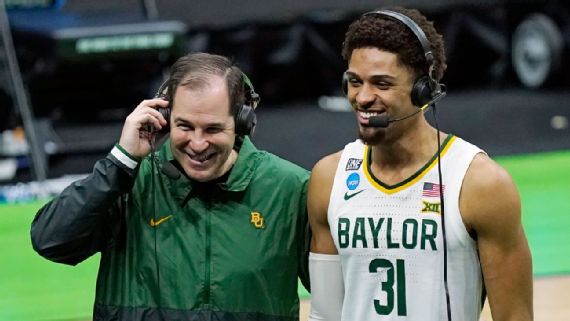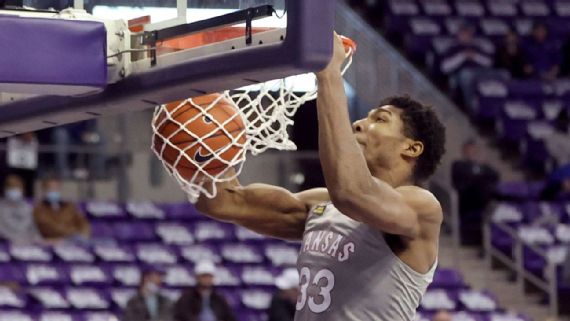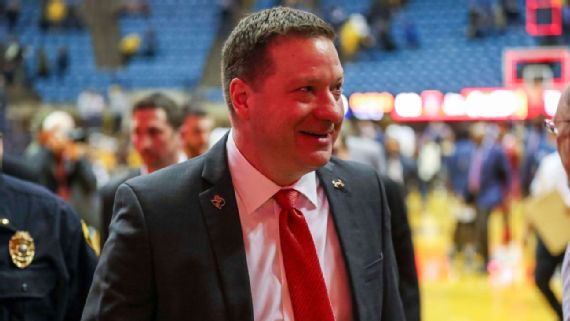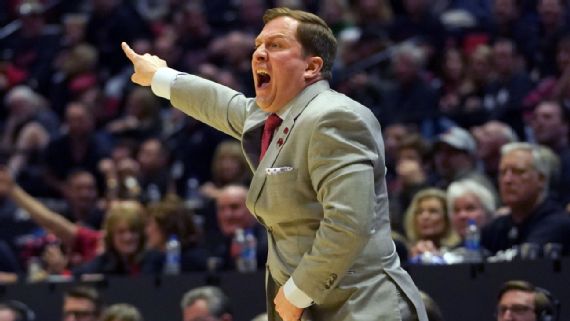Follow this link to read what anonymous coaches said about recruiting in the ACC, the Big East, the Big Ten, the Pac-12, the SEC, the AAC and the Big 12.
Name one critical piece of roster construction that led to Baylor’s first national championship in program history. Why do you think it was so meaningful?
Medcalf: I think it makes sense to put the spotlight on the immediate contributions of the program-altering transfers who led Baylor to its first national title in school history. You don’t win that title without MaCio Teague, Davion Mitchell and Adam Flagler. You could probably count Jared Butler too since he was originally headed to Tuscaloosa.
But the most critical addition to the program arrived in 2003, when the school convinced a young coach who’d just won 20 games at Valparaiso, the school his father had led to a miraculous moment in 1998, to leave his post and inherit one of the worst situations in college basketball history. Yes, it was Scott Drew’s big opportunity to coach a major program and he knew it was a significant opportunity. But he wouldn’t have been the first young coach to say no to a bigger salary when it came with major fallout – which in Baylor’s case included the murder of a player, a conviction of another player for that murder and a head coach who tried to cover up the whole thing.
Drew’s program has been building up to this current run for a long time, with two Elite Eight runs and two trips to the Sweet 16 before this, but Baylor got lucky when Drew said yes. None of this happens without that decision in 2003.
Borzello: It has to be transfers. Of the five players who saw 20 or more minutes in the national title game against Gonzaga, four of them started their careers somewhere else. Mitchell was a bench piece at Auburn; Drew dipped into the Big South for both Teague and Flagler; and as Myron mentioned, Butler signed with Alabama before looking elsewhere a couple months before the 2018-19 season began.
Drew changed the way he approached recruiting after landing a string of five-star prospects a decade ago. While the talent in Waco was consistently at a high level, it didn’t consistently lead to late March success. He instead began to find guys that would buy in and fit what he wanted to do, while supplementing those players every offseason with transfers.
Drew has also had success redshirting players; much of that has to do with transfers, of course, but Mark Vital also redshirted as a freshman, and past players like Cory Jefferson and Johnathan Motley also spent a year in Waco redshirting. Here’s all the proof you need about Drew’s change in recruiting: Baylor signing Kendall Brown last fall was the Bears’ first five-star prospect since 2012.

Gasaway: It’s not college basketball unless you’re arguing about whether veterans or one-and-dones will win you the national title. Baylor didn’t do it with extreme youth, of course, but you can make a case that continuity was even more important than age for the Bears in 2020-21.
This was a rotation that lost only Freddie Gillespie and Devonte Bandoo from the previous season (though Tristan Clark saw limited action in 2019-20 before being sidelined by a knee injury that also cost him the following year). Meaning that for two consecutive seasons, BU was defined by a backcourt consisting of Butler, Mitchell and Teague, while Vital locked down the paint at both ends of the floor. That was a winning combination two years ago (at 26-4, Baylor was likely on its way to a No. 1 seed in a 2020 tournament that never happened) and it was next to unbeatable last season.
“Get old and stay old” is the popular saying among coaches. Well, the Bears won it all in April with “just” two seniors (Teague and Vital) because, who knows, maybe continuity is just as important as age. When you can construct your roster to get top-tier college performance out of returning veterans not yet drawing sufficient interest from the NBA, you have a shot at what Drew put together in 2021.
Lunardi: Baylor was a perfect college team in the current era: older, but not too old to be stale; skilled, but not too skilled to lose guys a year early; and balanced, but with an appropriate emphasis on perimeter play at both ends of the floor. If not for Baylor’s late-season pandemic woes, we may have had two unbeaten teams in the national title game and an even more historic outcome. The most critical piece? Scott Drew, who took the job when everyone said it was a bad idea, and then had the vision and perseverance to see it through. And the Bears may not be finished.
Kansas looks like a team with Final Four potential in 2021-22. Name one thing you like about this roster, and one thing that worries you.
Borzello: The biggest issue for Kansas last season was the Jayhawks’ lack of a consistent go-to scorer who could go get a bucket when needed. Devon Dotson filled that role a couple years ago, and Bill Self has seemingly always had a guard to fill that role. Frank Mason, Devonte Graham, even Tyshawn Taylor as a senior back in 2012. And going into this offseason, that looked like it could be an issue again — but Self likely solved that problem by landing Arizona State transfer Remy Martin, arguably the country’s best transfer. Martin was a two-time first-team All-Pac-12 selection, and one of the best scorers in the country.
With that issue solved, I don’t have too many concerns — but Kansas wasn’t a very good 3-point shooting team last season (32.7% in Big 12 play) and Ochai Agbaji, the team’s leading 3-point shooter, could decide to keep his name in the NBA draft. Agbaji caused matchup issues for opponents given his physicality and shooting ability, and while Self is bringing in a slew of talented transfers and newcomers, they will have to improve the team’s perimeter shooting.
Gasaway: I like the defense with this roster. The Big 12 made less than 45% of its 2s against these guys last year, and the return of David McCormack should help keep that number low in the coming season. Self’s best teams have almost always forced misses in the paint, and it would appear that box is checked for 2021-22.
What I don’t like as much, diametrically enough, is the KU offense. I love Remy Martin’s game and Kansas fans with long memories can still recall what Martin and his Arizona State teammates were able to do in the Sun Devils’ win at Allen Fieldhouse in December of 2018. Still, Martin’s going to need help, and last season — from 2- and 3-point accuracy to shot volume to you name it — the Jayhawk offense was average across the board in conference play.

Medcalf: I love the leap of McCormack from his sophomore to junior seasons. He had a few misses throughout the year, but Kansas was a challenge for any team in America when he played his best basketball. That double-digit win over Baylor that made a lot of us (or maybe just me) second-guess the Bears’ national title aspirations? Sure, fatigue after Baylor’s COVID-19 pause was a factor, but McCormack’s 20 points and three blocks changed the game. That guy is a potential All-American in 2021-22, and Bill Self’s best teams have always included reliable bigs — you pair him with Martin and the Jayhawks will have one of the nation’s top inside-outside combos.
What worries me is that no one in America seems to have a clue about the next steps in this independent review process involving Kansas and other schools tied to the FBI scandal. What’s the next move? Will we get news before this season? During the season? And if there is a severe penalty (schools cannot appeal the independent review panel’s decisions), what will that mean? Kansas is still walking into a season full of unknowns with its infractions case.
Lunardi: Most know I am a student of NCAA tournament history. When a program is a top four seed for 18 consecutive seasons — and a No. 1 seed in fully half of those years — success goes beyond individual roster moves. The program is obviously positioned and administered in a way that failure is never an option. Such is Kansas, which has been caught by Baylor for the time being and perhaps threatened next in the Big 12 by Texas, yet is unsurpassed in terms of staying power and consistency. What I like most about the Jayhawks for next season is simply that they’re due, both to return to the top of the conference and for a long tournament run.
New Texas coach Chris Beard will be among the most scrutinized coaches in the country in 2021-22 (and beyond). Do you expect his recruiting philosophy to change? What are your long-term expectations for the Texas program?
Medcalf: I don’t think Chris Beard will change. He’s always gone after the top available talent. Now, he’s attached to one of the most recognizable brands in college basketball and he’ll have more access to those elite prospects. He’ll always battle powerhouse programs for talent in the rich pools of Dallas and Houston, but I think Beard will get a bunch of the best prospects and make Texas a perennial threat in the Big 12.
But we’ve also said this a few times for Texas. Rick Barnes reached the Final Four but couldn’t find that magic again. Shaka Smart had more buzz than any young coach in the country but kept hitting a wall in the postseason. Maybe Beard will be different. Texas has the potential (a new arena will open in 2022), long-term, to become a force in college basketball. But with Baylor and Houston in the area, Texas first has to become the best program in its own state before it can consider those ambitions.
Borzello: Beard began changing his recruiting philosophy over his final couple seasons in Texas Tech, after the Red Raiders started having consistent success on the court. He signed Texas Tech’s first ESPN 100 prospect since 2007 in 2018, then signed the program’s highest-ranked recruit in 2019 — a record that lasted just one year before he signed the program’s first five-star recruit in the ESPN recruiting era. So he had clearly began moving away from the more gritty, under-the-radar prospects with whom he started his Lubbock tenure.
I expect Beard to continue to recruit in the five-star waters now that he’s at Texas, and the Longhorns have already had several five-star prospects on campus since he arrived in Austin. He’s also clearly going to hit the transfer portal in a major way; he’s signed five high-major transfers already and is heavily in the mix for UMass transfer Tre Mitchell, the top-ranked transfer available. With the talent Beard is bringing in, along with his coaching ability and the recruiting acumen of his assistants, Texas should regularly be competing for conference titles and Final Fours.

Gasaway: My expectation is that Beard will get blue-chip recruits to play outstanding defense. He won’t be the first coach to do so, of course. Self and John Calipari, to name two mainstays, have rather extensive track records in this area and let us not forget that Ben Howland had a rather spectacular if fleeting moment in this space at UCLA roughly 15 years ago. Now it’s Beard’s turn.
The Texas program was already a revolving door for NBA-track talent even before the ex-Texas Tech coach’s arrival. That level of recruiting is likely to continue, while the defense is in all likelihood due for an upgrade.
Lunardi: It’s U.S. Open week, so let’s use a golf analogy: Best player never to win a major? In college basketball, the equivalent question is this: What’s the top program yet to win a national championship? Given the events of the current offseason, I think a legitimate argument could be made for the Texas Longhorns. They have all the resources in the world, plenty of top players in the state, and now a world-class jockey. I don’t know what the odds are for Texas to win a title in the next five years, but count me in on that action.
There are three more new coaches in the league beyond Beard: Porter Moser (Oklahoma), Mark Adams (Texas Tech) and T.J. Otzelberger (Iowa State). Pick one of these three and offer them a blueprint for success in this difficult league.
Gasaway: Porter Moser could do worse than take a page from Lon Kruger’s book at Oklahoma. The previous coach in Norman reached seven of the last eight NCAA tournaments that were played, and he did it, for the most part, with recruits who were more blue-collar than blue-chip. To be sure, a guy named Trae Young did play for Kruger and senior-year Buddy Hield was no slouch either. Nevertheless, for every season with a Young or a Hield, there were two or three others with a cohesive group of veterans taking exceptionally good care of the ball and playing strong defense. Which, come to think of it, sounds a bit like Loyola Chicago last season. Moser should feel right at home.
Lunardi: I’m also in the Moser camp, not just because of track record, but because Oklahoma — from the top down — has the most going for it. Athletic director Joe Castiglione is at the top of the profession and the Sooners want for nothing in any sport. Who has dominated Big 12 berths in the college football playoff? Who has turned the Women’s College World Series into a personal playground? Who always seems to be ahead of the curve in hiring the next big-time coach? If any of the league’s “next tier” can hang with Kansas, Baylor and Texas in the next few years, it’d be Oklahoma.

Borzello: I think T.J. Otzelberger is going to have to rebuild Iowa State the same way Fred Hoiberg did during his time in Ames. Fortunately for Cyclones fans, Otzelberger has plenty of experience in that department — he was an assistant at Iowa State for eight years, four of those coming under Hoiberg.
Iowa State isn’t a place where you can consistently rely on in-state high school talent to keep you afloat; you need to get creative. Hoiberg went to four straight NCAA tournaments with rosters built mostly on transfers, along with Canadian prospects and some prep school prospects from New England and the Northeast. Otzelberger has strong Midwest ties and will be able to dip into Wisconsin and other neighboring states for high school prospects, but he will need to work the transfer portal heavily.
Medcalf: Otzelberger already knows what to do, as Jeff says, and will identify top players and promote the rowdy atmosphere on the team’s home floor and its great facilities. More than anything, however, he should mention to prospects that Monte’ Morris, Tyrese Haliburton, Georges Niang and other Iowa State products are on NBA rosters right now. I think he has to sell ISU not just as a program with a chance to make its mark in the NCAA tournament but also as a place where you can grow and eventually get paid at the next level.
Credit: Source link